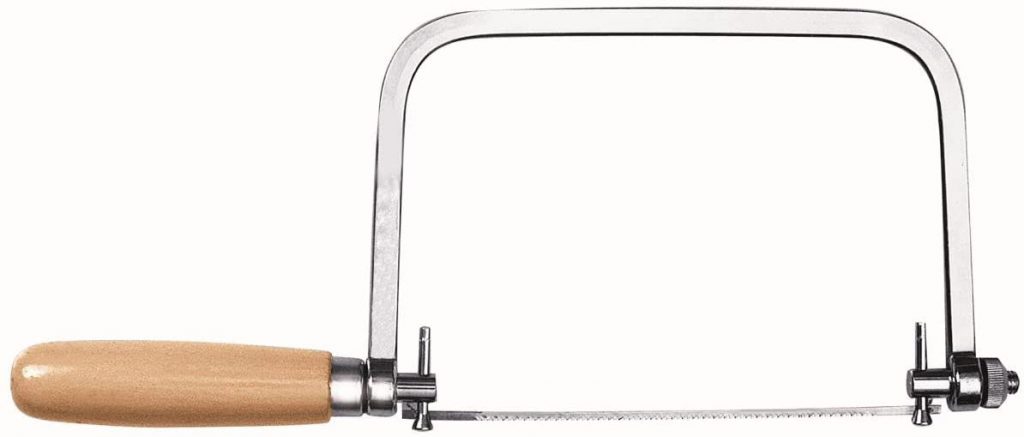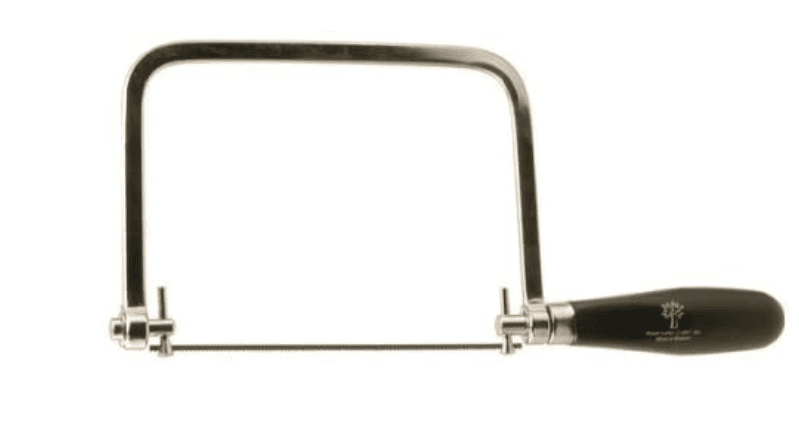Coping Saw
A coping saw is that thin-bladed, hunchbacked manual handsaw great for intricate scroll cuts, trim work, and coped molding cuts.
For the most part, the 6 1/2-inch long, 1/8-inch wide carbon steel blade is stretched tightly between the two ends of a 4 1/2-inch to 5-inch U-shaped steel frame held in place by spigots that allow the user to loosen and move the blade to different angles.
Most often used with the blade positioned to cut on the pull stroke, it can be turned around to cut on the push stroke.
Television personality and skilled woodworker Norm Abram said that a coping saw is one of the few types of saws that he keeps in his tool chest for everyday precise cutting challenges.
In addition to inside molding corner joints, coping saws are nice for inside, tight radii holes. To use the saw this way, bore a hole in what will be waste following the cut, insert the blade into the hole and re-attach it to the saw’s frame and cutaway.
The blades range from 10 to 20 teeth per inch.
According to the authors of Basic Carpentry at Sunset Books, it helps to clamp the piece of wood that you’re working on to a workbench or in a vise to hold it fixed while you make a coping cut.
The average homeowner might find when buying a coping saw that the tendency is to go cheap because making coped joints isn’t something he or she plans to do too often, but that could be a frustrating mistake.
If the frame is too flimsy, the blade can’t be kept rigid enough to make an accurate, clean cut.
An ingenious technique called coping can get a good fit at molding joints in inside corners.
A finished coped joint appears to be a perfect miter, in which the ends of two mating pieces of molding are cut at 45 degrees. In coping, however, only one of the pieces needs to be cut.
Here’s how to cope a joint
- Put the molding in a miter box and make a 45-degree cut, in the end, to be joined, using a backsaw or fine-toothed hand saw. This cut exposes the molding profile on its front side and leaves a wedge of wood extending beyond the profile.
- Remove the molding from the miter box and outline the profile with a pencil for better visibility while completing the cut. Next, position the molding on a workbench or other surface so the cut end can be trimmed.
- Use a coping saw — a special handsaw with a very narrow blade and U-shaped spine — to cut along the molding profile and remove the wedge-shaped piece of wood left by the miter saw that extends beyond the profile. It is best to angle the coping saw slightly to remove a little more wood from the backside of the molding than the front, but the front profile must be followed exactly.
- The coped cut should form a duplicate of the shape of the molding face that the coped piece will join. The coped piece and its mate can then be butted together neatly at the inside corner.
- Test fit the pieces, and trim the coped joint if necessary with sandpaper or a sharp knife.
- A properly coped joint will fit well even if the walls don’t meet exactly 90 degrees (few walls do).
Some other tips for installing molding
- When marking molding for saw cuts, make a small X or other marks on the waste side of the cutting line. This ensures that the cut won’t be made on the wrong side of the line and produce a molding that is short of the intended length.
- When possible, paint or finish molding before nailing it in place. The result of prefinishing will be a better appearance and less mess.
- Molding is installed with finishing nails, and slender nails with small heads. Even though the nails are thin, molding is often so fragile and easily split that it is best to drill a pilot hole through the molding before inserting a nail.
- Drive nails until the heads almost reach the wood, then use a nail set to countersink the heads slightly below the surface. Fill the holes over the nail heads with wood putty.
Buying Guide for Coping Saws
Even though many people are claiming that their product is the best available, you should still conduct your own research because there is no guarantee that the product was designed with you and your difficult assignments in mind.
As a repercussion, we deeply recommend that you conduct extensive work to investigate which coping saw is truly the best fit for you and which ones you should avoid.
There are several aspects of these saws to take into account, and we will go over all of those in detail to find relevant information when purchasing a coping saw to help you with your woodworking project.
What factors should you consider when purchasing a coping saw?
Installation of the blade
The most important aspect is blade installation, which must be taken into account. On most blades, a gear is attached to either end of the socket. When cutting wood with a saw, the clip prevents the blade from slipping.
The blades Rotation
What is the rotational speed (and accuracy) of the blade? Any coping saw without detents cannot be considered the best coping equipment.
The blades’ quality
The quality of the blade is another important factor to look for and consider when purchasing a coping saw.
Bimetallic blades are used in a variety of saws. In some cases, carbon steel blades are used. The blade bottom is made from steel that does seem to be lighter in weight yet is still flexing easily.
Materials
It is potentially amongst the most key aspects to consider when buying a saw as it will, in the end, determine the overall quality of the tool-making process.
Although other factors influence the smaller structures involved, the quality of workmanship is typically used to determine the maximum stresses that a coping saw can withstand.
In this case, a coping saw made of high-quality metal for the frame and outside portions of the handle will suffice.
What characteristics should a coping saw have?
Throat
A coping saw’s throat is the space between the blade and the frame. It is critical in determining the type of project and spaces the saw can work on.
This isn’t simply a case of “bigger is better,” because a narrower throat allows you to cut more effectively in tight spaces.
Given how often pipe saws are used, this can result in real-time savings. under the right conditions. However, you should always purchase the best saw for the job.
Connection
There are several types of saw linkages, but one is far more common than the others. A coping saw with a spindle shape and two gears integrated into the cutting mechanism at the blade’s end is the most common type.
Although most coping saws have blade tensioning systems, this is not always the case. In power transmission saws, the alternative method necessitates the use of a spindle mechanism and open hand blades.
Tension
To change the angle of the frame, some saws have a tensioning device that spins outside the frame. The blade tension on most coping saws can be adjusted via the mounting pins; however, this can be a little more complicated.
Ergonomics
While it may not appear appealing, ergonomics is critical if you intend to use it for a variety of tasks. Another method for making it easier to use a saw for longer periods of time is to activate the ergonomic handle.
What are the various types of coping saw blades?
Wood
You can use a coarse blade with 15 TPI (Teeth per Inch) or less to cut through the wood because it removes material quickly and allows you to cut in a straight line.
Coarse blades are usually sufficient for cutting wood. If you have to cut along curved lines, you’ll need blades with a TPI greater than 18, but they’ll be slower.
316L stainless steel
Cutting metal necessitates the use of a strong blade made of high-carbon steel, which will allow you to easily slice through non-hardened metal.
Plastic
We suggest using a helical teeth blade to easily cut through the plastic. They’re not particularly fancy, but they’re perfect for this type of fabric.
What exactly is the function of a coping saw?
Coping saws come in handy in a few situations where they are the best tool for the job. It’s one of the best tools for, say, cutting holes inside a solid block of wood.
Because the blade of a coping saw is quickly detachable, all you have to do is bore a hole in the middle of the object, insert the blade, and restore the frame.
The hole can next be enlarged and turned into a design in the center of the wood. One example is carving a design, such as a heart or a star, into the back of a wooden chair.
The Best Coping Saw Of 2022
Robert Larson Coping Saw – Best 2022
The fact that this tool was developed in Germany is a huge selling point for prospective buyers. Why?
There is an outstanding level of trust in products made in this country because they are frequently built to last. Without a doubt, this saw lives up to its name in terms of durability.
Even if the handle is wood polished, it has a solid metal structure that will last for years of continuous use.
The tool blade has the advantage of being simple to adjust the tension, making it quick and easy to use.
When the blade wears out, it is simple to replace it with a tool that accepts standard saw blades.
F.A.Q
Q: Why is it called a coping saw?
A: Coping is the top course of a curved or sloping brick or stone wall. As a consequence, this term appears to refer to curved finishes on wooden items such as skirting. Using a coping saw, the wood is then coped to meet the curvature!
Q: What is the thickest material that a coping saw can cut?
A: The size of the frame determines this. After you’ve cut to the depth of the frame, you won’t be able to go much deeper because the thing you’re cutting will block you.
Q: What would be the most effective use of a coping saw?
A: They are ideal for cutting intricate forms and matching corners for beautiful miters. They’re commonly found on skirting boards.

























